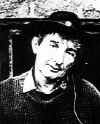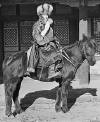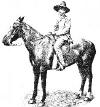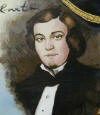Many places come to mind when one thinks of the dangerous and unexplored places of the nineteenth century world. Africa and Tibet, for example, both challenged brave explorers in that previous age. Yet one continent, though often overlooked, offered all the adventure a daredevil could want. South America was still politically unstable and geographically challenging. It was exactly for these reasons that George Whitfield Ray came sailing into Buenos Aires in 1889. A Fellow of the Royal Geographic Society, Ray was a part-time missionary and full-time adventure junky. Within a short time he had managed to acquire a job as “Official Explorer for the Bolivian Government”. Shortly thereafter he began a series of explorations and misadventures which still make for hair-raising reading. Ray’s account of his South American travels, Through Five Republics on Horseback was gathered from his years spent exploring the untouched interior, visiting unknown tribes, and making careful observations of native life in a host of countries. Yet it was his equestrian adventures that made Ray justly famous. On his most noted horse trip into the interior, the equestrian explorer set out to find a lost tribe of sun-worshipping natives who resided in the unexplored forests of Paraguay. Ray’s story Green Hell describes a journey so brutal that it defies belief. The horses were repeatedly attacked by vampire bats, thousands of which lived in nearby jungle caves. Then Ray and his horses were reduced to sucking dew off leaves to survive. By the time he discovered the tribe, Ray’s clothes were in rags, held together by horse hair thread. The intrepid American did eventually ride back to civilization, but not without paying a price for his boldness. He lost two toes to blood-sucking insects whose bites also caused much of the flesh on his feet to rot off.

Susanna Carson Rijnhart
was a Canadian Long Rider who not only suffered tremendous emotional
heartache, she also had to protect herself against sexual predators when she was
most vulnerable. Carson had been practising as a doctor in Toronto for six
years when a Dutch missionary named Petrus Rijnhart arrived in 1894 to
discuss his work along the dangerous border between China and Tibet. The
charismatic Rijnhart made such an impression on Susie that they quickly
married and she returned with him to China.
After having settled in a remote part of China, they leaned Tibetan. Their intention was to ride to Lhasa, which had not been visited by Westerners since 1846. In November, 1897 Swedish Long Rider Sven Hedin visited their home on his way out of the “hermit kingdom.” The tough explorer praised Susie’s medical work, noted that she wore local clothes and had befriended many locals.
The Rijnharts' departure was delayed by the birth of their son, Charles, in June, 1897. But less than a year later, in May, 1898, Susie and Petrus set off for Lhasa. The elusive capital was nearly a thousand miles away. In between lay hostile tribes, soaring mountains and an aggressive climate. No matter. They hired two Chinese men as servants, employed a reliable Ladakhi as a guide, packed supplies, Bibles and baby Charles onto the pack horses, then set off into the unknown.
Alas, religious purity wasn’t enough to protect their dreams. The Chinese servants deserted. Their pack horses were stolen. Baby Charles died. The guide quit. Only a hundred miles from Lhasa, the Tibetans blocked their progress and ordered the weary Long Riders to return to China. Then things really got bad.
Having struggled through an early September snow storm, Susie and her husband were attacked by bandits. Most of their horses and the majority of their remaining possessions were lost. Because of their desperate situation, Petrus left his wife to seek help from Tibetans camped on the far side of a raging river. He was never seen again.
Susie Carson had come a long way from Canada. Now she was left in Tibet with nothing except a revolver, some silver bullion and her faith. She rode on. Eventually Susie was able to engage Tibetans to act as guides but they attempted to rape her. The beleaguered Long Rider held them off with her pistol then pushed on alone. After crossing numerous mountains, Susie arrived back in China frost-bitten, penniless and in rags. She had been gone six months.



W. C. Rose - Though the Historical Long Riders project is filled with extraordinary equestrian journeys, few are as unique, nor its rider more mysterious, than Captain W. C. Rose. It was the famous English Long Rider, Roger Pocock, who introduced Rose to their fellow countrymen. This occurred in 1907 when Pocock, who had made a tremendous solo ride along the length of the Outlaw Trail a few years earlier, told readers of England’s Wide World magazine about Rose’s equally astonishing adventures.
According to a lengthy, detailed account written by Rose, after having made his fortune in the California gold mines, he journeyed south to Mazatlan, Mexico. Rose had barely arrived when he happened to see two men being attacked by a dozen brigands. Though he lacked the necessary Spanish, the impetuous traveller didn’t hesitate to attempt a rescue.
“They did not understand my words, but my levelled Colts conveyed my meaning readily enough.”
Pedro and Jose, the two Mexicans Rose had rescued, were so grateful that they decided to accompany the English Long Rider on his equestrian journey from Mexico to Argentina. The resultant story is unlike anything else in Long Rider records.
Rose begins by describing their ride through the Mexican countryside, noting the wildlife and providing many geographic clues as to the group’s southern progress. During their ride, they hunted jaguars, attended weddings, survived scorpion bites and experienced the day to day misadventures which any lengthy equestrian journey will surely encounter. Rose next provides information about their entry into Guatemala, which indicated that they ridden the length of Mexico. According to the account, they then passed through El Salvador, Honduras, Costa Rica, Nicaragua and Panama. Rose does not explain how his party avoided the infamous Darien Gap jungle, which separates Panama from Columbia, but it was common for travellers to sail between the two countries so as to avoid this swampy green hell.
When the account continues, Rose mentions riding through Columbia, Ecuador and Peru, Then they entered the notorious Gran Chaco jungle of Paraguay. No outsider would thoroughly explore this insect-infested wilderness on horseback until the 1920s, when Welsh Long Rider Thurlow Craig ventured in on his grey Criollo, Bobby. Finally, after surviving enough hair-raising adventures to have slain an army of mortal men, the weary trio finally rode into Corrientes, Argentina
The Long Riders' Guild can find very little information about the author, except for the fact that he died of heart disease in 1912 in an hotel in San Francisco, in his fiftieth year. Whereas we believe Rose made the journey, because it appears to be vouched for by that equestrian travel expert, Long Rider Roger Pocock, some of the episodes described do seem somewhat far-fetched. While the jury is still out in regards to the specifics of the journey, evidence clearly indicates that Rose was indeed involved in the day to day experiences of an extremely long, and perilous, equestrian journey. One point he made perfectly clear, was the high regard in which he held the beloved horse who accompanied him during the length of this Odyssean journey.
“And now,” Rose wrote, “I crave to be permitted a few lines in just praise of my noble mare, which carried me faithfully and well during my long, long ride. She was a half-breed between a "bronco" and a pure Spanish thoroughbred, stood about fourteen and a half hands, was as swift as an arrow, surefooted as a goat, and almost indefatigable. She was a beauty, endowed with great intelligence, and of a very amiable and docile character. She twice saved my life, and, as I have said, carried me all the way from Mexico to the Argentine. When, after the termination of our journey, I made a present of Pepita to Pedro, he said it was the greatest token of friendship I could have given him. He was right: parting from her made me weep like a woman for the first time in my life.”
Those are the sentiments of a Long Rider, past or present.
Here is a link to his astonishing Story from the Road entitled “Six Thousand Miles on Horseback".
Countess von Rosen wrote, "It is lovely this life. I feel it when I ride against the storm, and the horse rears up, his hooves dancing in the air. In that mad second, before my mount takes off in senseless fainting speed, I scream against the storm, I'm alive!"

Considered one of the finest travel accounts of its era, Adventures in Mexico describes the equestrian exploits of its famous author, George Ruxton, a young British army officer who rode from the port of Vera Cruz to the fabled walls of Santa Fe, Mexico in 1847. It is a true tale of rough adventure filled with detailed descriptions of Indians, Mexicans and Americans. When the English horseman met famed Mexican General Santa Ana, for example, he caustically noted that his host was short, overweight, sported a peg leg, and married to a woman many years his junior. At times Ruxton exhibits a fearlessness which borders on insanity. He ignores dire warnings, rides through deadly deserts, and dares murderers to attack him.
